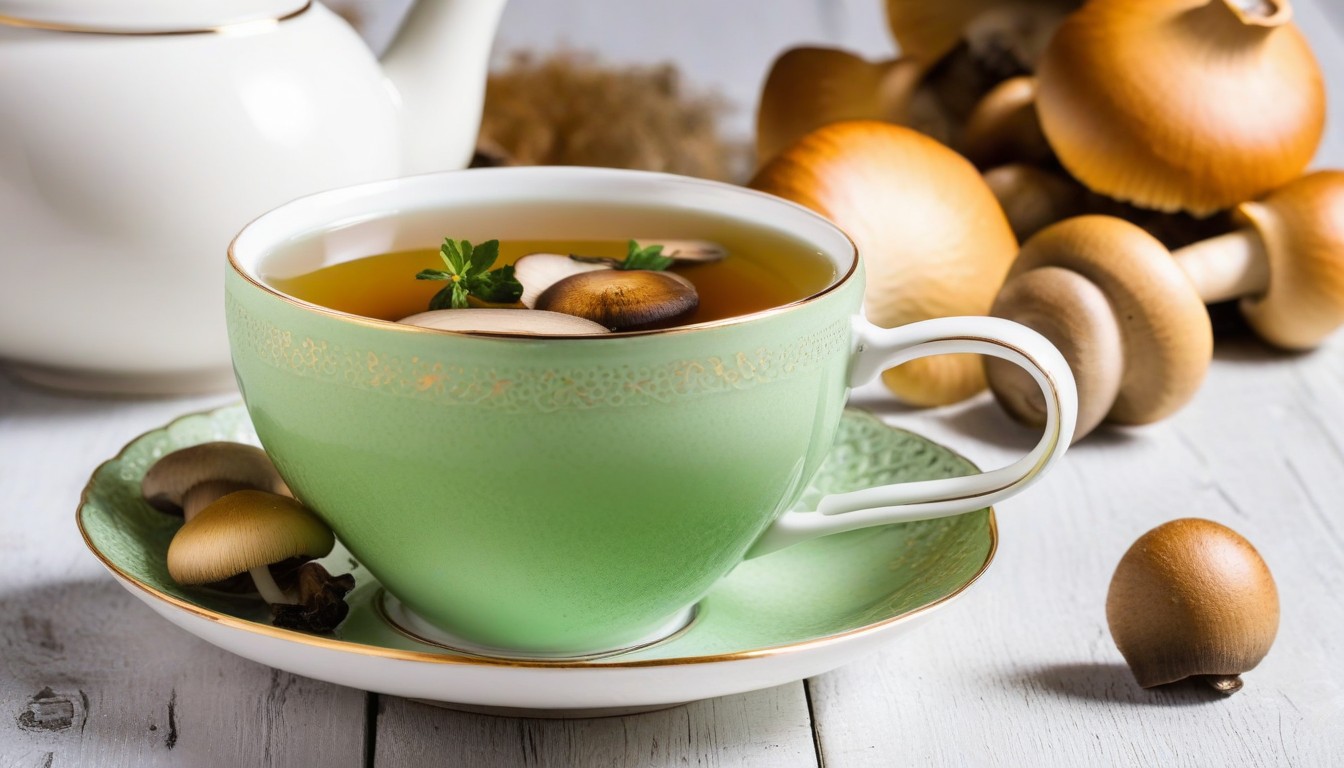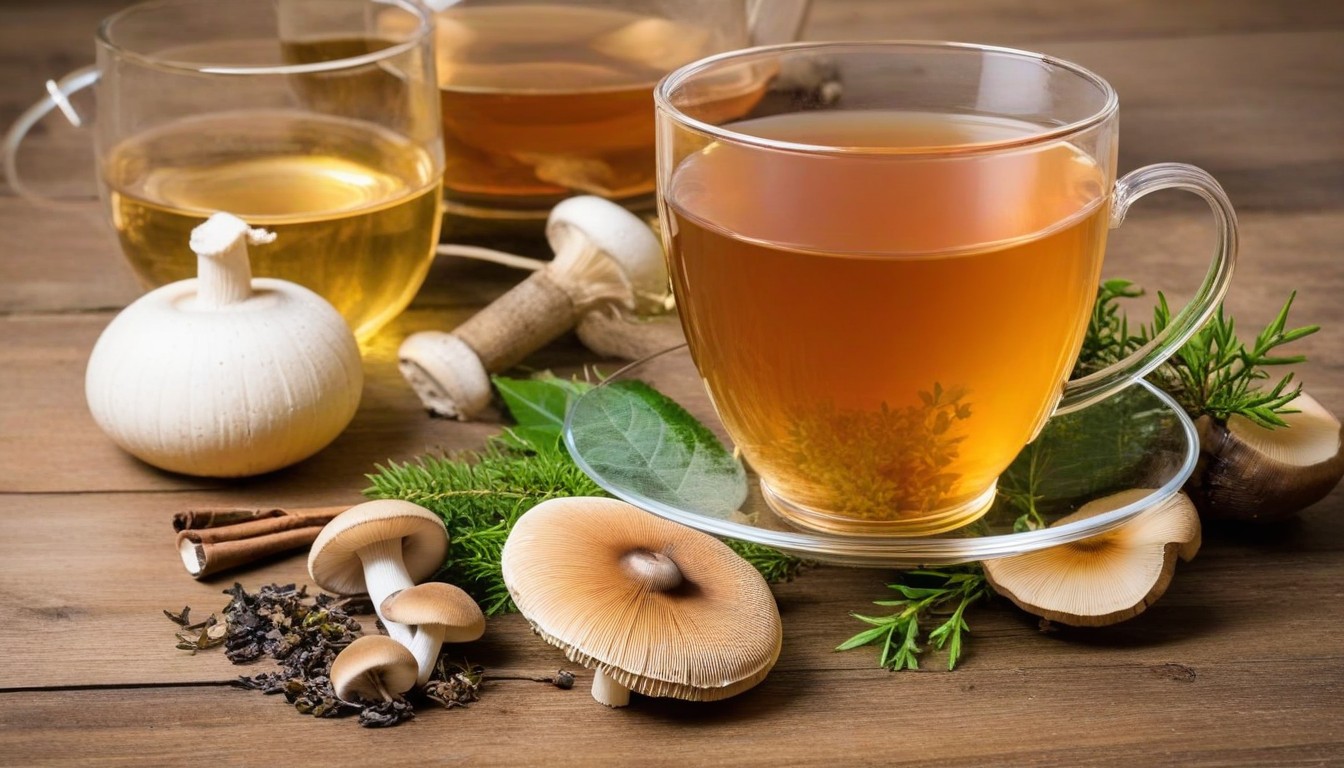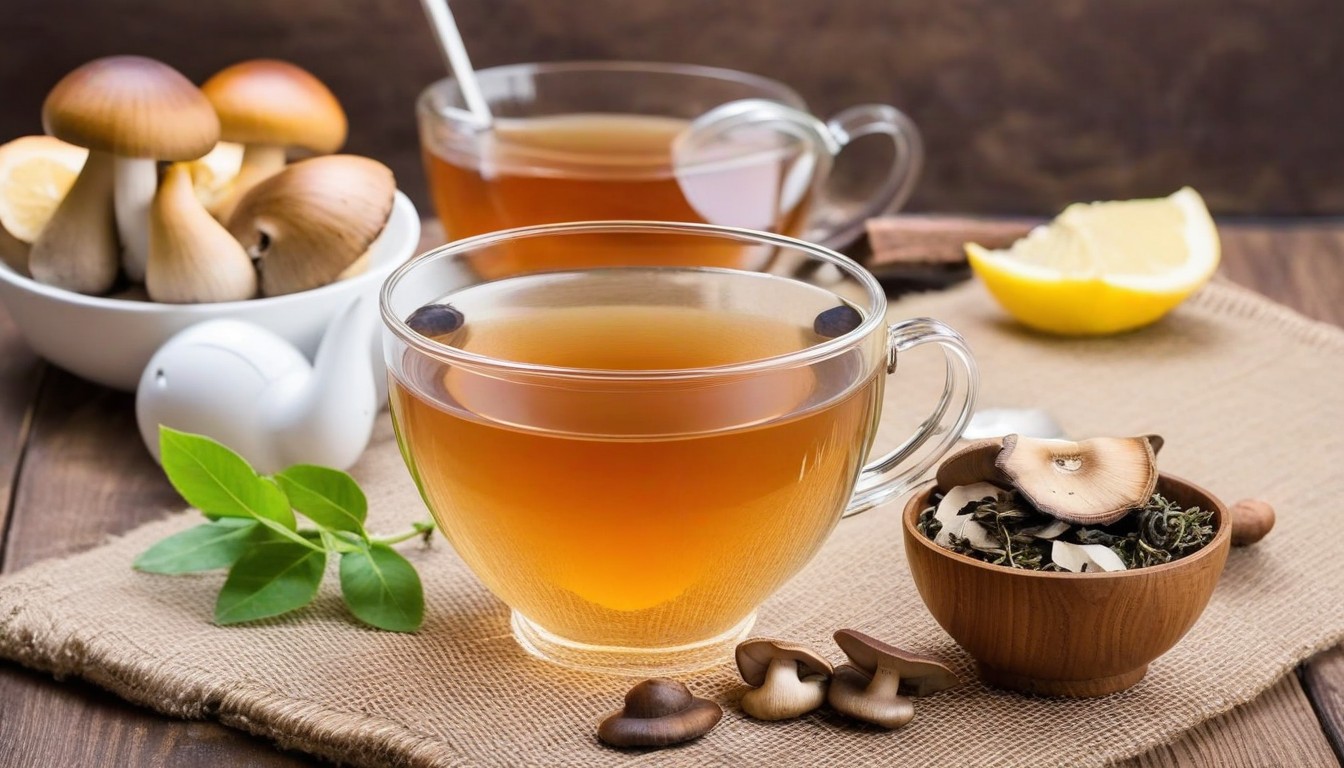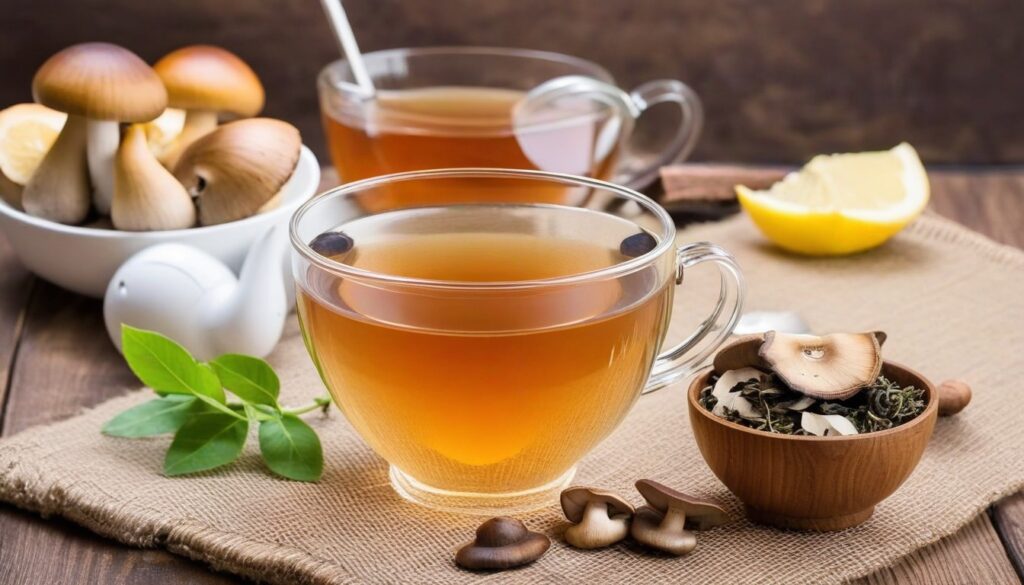If you’re looking for a unique twist to your regular tea cup, why not try making tea with mushrooms? Not only is it a delicious way to enjoy the earthy flavors of mushrooms, but it also comes with a host of health benefits. In this section, we will provide you with a simple method on how to make this tea that you can easily follow to achieve optimal taste and health benefits.
Key Takeaways
- Learn how to make tea with mushrooms in just a few simple steps.
- Enjoy the unique and delicious earthy flavors of mushroom tea.
- Benefit from the many health advantages that mushroom tea has to offer.
Understanding the Benefits of Mushroom Tea
Before diving into the process of making mushroom tea, let’s explore the numerous benefits it offers. Mushroom tea is a popular beverage that has been used for centuries due to its health benefits.
Boosts Immune System
One of the most significant benefits of mushroom tea is that it can help boost your immune system. According to research, certain mushrooms contain beta-glucans, which are polysaccharides that have immune-enhancing properties. These compounds can stimulate the activities of white blood cells, which can help fight off infections and diseases.
Improves Digestion
Mushroom teas can also aid in digestion. They contain chitin, a compound that can help break down food and improve the absorption of nutrients. Furthermore, they may contain enzymes that prevent bloating and gas, making mushroom tea an excellent beverage to consume after meals.
Reduces Inflammation
Another benefit of mushroom tea is that it can help reduce inflammation. Certain mushrooms such as reishi and chaga contain antioxidants that can help neutralize free radicals, which can cause inflammation in the body. Studies have also shown that these mushrooms may have anti-inflammatory properties that can help alleviate inflammatory conditions such as arthritis and asthma.
Natural Source of Antioxidants
Mushroom teas are also a natural source of antioxidants. These compounds can help protect the body from damage caused by free radicals, which can lead to chronic diseases such as cancer and heart disease. Additionally, certain mushrooms such as lion’s mane contain erinacines, which can stimulate the production of nerve growth factor (NGF) in the brain. NGF is a protein that can help protect brain cells from damage and promote the development of new ones.
Overall, mushroom tea is an excellent beverage to add to your daily routine, offering many health benefits. In the next section, we will guide you on selecting the right mushrooms to make the perfect cup of tea.
Choosing the Right Mushroom for Tea
Not all mushrooms are suitable for making tea. Choosing the right type of mushroom is crucial to get maximum health benefits and optimal taste. The commonly used mushrooms for brewing tea are reishi, chaga, and lion’s mane. Each mushroom has its unique properties that contribute to the health benefits of the tea.
|
Mushroom |
Properties |
|---|---|
|
Reishi |
Known for its immune-boosting and anti-inflammatory properties. It can also improve sleep and reduce stress. |
|
Chaga |
A potent source of antioxidants that can improve skin health and slow down the aging process. It can also boost the immune system and reduce inflammation. |
|
Lion’s Mane |
Can enhance cognitive function and improve memory. It can also promote nerve regeneration and reduce inflammation. |
When selecting mushrooms, make sure to use quality sources from reputable suppliers. It’s also important to verify the authenticity of wild mushrooms, as some varieties can be toxic and harmful.
Gathering the Required Ingredients

Making mushroom tea requires a few essential ingredients that can be easily found in your kitchen or local grocery store. Here’s what you need:
|
Ingredients |
Quantity |
|---|---|
|
Mushrooms |
1-2 teaspoons of dried mushrooms or 3-4 slices of fresh mushrooms per cup of water |
|
Water |
1 cup per serving |
|
Tea bags or loose leaf tea |
1 bag or 1 teaspoon per serving (optional) |
|
Flavorings (optional) |
Honey, lemon, cinnamon sticks, ginger, or any other preferred flavorings |
You can choose from a variety of mushrooms to use in your tea, such as reishi, chaga, or lion’s mane, which are commonly found in health food stores or online. It’s important to use high-quality mushrooms from a reputable source to ensure their purity and potency.
When it comes to choosing tea, you can opt for either tea bags or loose leaf tea. If using loose leaf tea, a strainer is needed to separate the tea leaves from the liquid. For flavorings, try adding honey or lemon to complement the earthy taste of the mushrooms. Cinnamon sticks and ginger can also add a hint of warmth and spice.
Make sure to have all the ingredients on hand before starting the brewing process to avoid any interruptions. With the required ingredients, you can now move forward to the next step of preparing the mushrooms for tea.
Preparing the Mushrooms

Before you add the mushrooms to your tea, it’s crucial to properly prepare them to extract their beneficial compounds. Follow these simple steps:
- Wipe off any dirt or debris from the mushrooms using a damp paper towel or cloth. Avoid washing them under running water as mushrooms are porous and can absorb water.
- Use a sharp knife to slice the mushrooms into small pieces or crush them into small chunks. The smaller the pieces, the more surface area will be exposed to the water, which will result in a stronger tea.
- Some mushrooms, such as chaga, are extremely hard and may require grinding or pulverizing into a fine powder. You can use a coffee or spice grinder for this purpose.
- For a more potent tea, consider decarboxylating the mushrooms before adding them to the tea. This process involves heating the mushrooms in the oven to activate their beneficial compounds.
Now that your mushrooms are properly prepared, you’re ready to infuse them into your tea. Follow the next section carefully to ensure that your mushroom tea turns out perfect.
Infusing the Tea with Mushrooms
Now that you have your mushrooms ready, it’s time to infuse them into the tea. Follow these simple steps:
- Boil water in a pot or kettle.
- Add your preferred tea bag or loose leaf tea to a cup.
- Place the mushrooms into a tea infuser or strainer.
- Insert the infuser or strainer into the cup of tea.
- Pour the boiling water over the tea and mushrooms.
- Allow the tea to steep for 5-10 minutes to extract the beneficial compounds from the mushrooms.
- Remove the infuser or strainer and discard the used mushrooms.
- Add any optional flavorings, such as a teaspoon of honey or a squeeze of lemon, to enhance the taste if desired.
It’s important to note that the longer you steep the tea, the stronger the flavor will be. Be cautious not to steep for too long, as it may result in a bitter taste. Start with a shorter steep time and adjust to your preferred taste.
Tip: If you prefer a stronger mushroom flavor, you can brew a second cup of tea with the same mushrooms. However, the second cup may not be as potent as the first one.
Mushroom tea pairs well with a variety of tea flavors, including black, green, white, or herbal teas. You can experiment with different teas and mushrooms to create a unique and flavorful experience.
Adding Additional Flavorings (Optional)
While mushroom tea has a unique earthy flavor, some people prefer to add additional ingredients to complement or enhance its taste. Here are some optional flavorings you can add to your mushroom tea:
|
Ingredient |
Description |
|---|---|
|
Honey |
Provides natural sweetness to the tea and can help soothe a sore throat. |
|
Lemon |
Can add a refreshing citrus flavor and boost the tea’s antioxidant properties. |
|
Ginger |
Can add a spicy kick to the tea and help with digestion. |
|
Cinnamon |
Provides a warm, sweet flavor and can help stabilize blood sugar levels. |
Feel free to experiment with different flavor combinations to find your perfect blend. Just be careful not to add too much of any flavorings, as they can overpower the delicate taste of the mushrooms.
Straining and Serving the Tea

Once your mushroom tea has infused to your desired strength, it’s time to strain and serve. Straining the tea will remove any mushroom remnants, leaving you with a smooth and flavorful cup of tea.
To strain the tea, you will need a fine-mesh strainer, cheesecloth, or coffee filter. Place the strainer over a teapot or mug and slowly pour the tea through it. The strainer should catch any mushroom pieces, leaving only the liquid tea behind.
If you prefer a stronger tea, you can skip the straining step and consume the mushroom pieces along with your tea.
Next, it’s time to serve your mushroom tea! Pour the strained tea into a teapot or individual cups. If desired, you can add additional flavorings such as honey, lemon, or spices to enhance the taste.
Serving Suggestions
Mushroom tea can be served hot or cold, depending on your preference. Here are a few serving suggestions to make the most of your mushroom tea experience:
- For a warm and cozy beverage, serve your mushroom tea hot in your favorite mug.
- If you prefer a refreshing summer drink, pour your mushroom tea over ice and add a slice of lemon for a citrusy twist.
- Mushroom tea can also be used as a base for other tea blends. Try mixing it with green tea or mint tea for a unique flavor combination.
Whatever your serving preference, be sure to savor each sip and enjoy the many health benefits that mushroom tea has to offer.
Storing Mushroom Tea
If you have made a large batch of mushroom tea or have leftover tea, it’s important to know how to store it properly to maintain its freshness and potency. Mushroom tea can be stored in the refrigerator for up to three days or frozen for longer-term storage.
Storing Mushroom Tea in the Refrigerator
To store mushroom tea in the refrigerator:
- Let the tea cool down to room temperature.
- Pour the tea into an airtight container, leaving about an inch of space at the top.
- Seal the container and place it in the refrigerator.
When you’re ready to enjoy the tea, reheat it on the stovetop or in the microwave until it reaches your desired temperature.
Freezing Mushroom Tea
To freeze mushroom tea:
- Let the tea cool down to room temperature.
- Pour the tea into a freezer-safe container, leaving about an inch of space at the top.
- Seal the container and place it in the freezer.
You can freeze mushroom tea for up to three months. When you’re ready to drink the tea, thaw it in the refrigerator overnight, then reheat it on the stovetop or in the microwave until it’s hot.
Important Tips for Storing Mushroom Tea
When storing mushroom tea, it’s essential to follow a few guidelines to prevent contamination and maintain its quality:
- Always use a clean container to store the tea.
- Don’t keep mushroom tea at room temperature for more than two hours.
- Don’t reheat mushroom tea more than once.
- Check the tea’s aroma and appearance before drinking it. If it smells or looks off, discard it.
Pro Tip: Consider freezing mushroom tea in ice cube trays, then adding the cubes to your favorite smoothie or hot beverage for an easy and delicious way to boost your daily nutrient intake.
Exploring Different Mushroom Tea Variations

Mushroom tea can be enjoyed in numerous variations, each with its unique taste and health benefits. Here are some mushroom tea variations to try:
Reishi Mushroom Tea
Known as the “mushroom of immortality,” reishi mushrooms are popular for their potential health benefits. To make reishi mushroom tea, steep dried reishi mushroom slices in boiling water for 10-15 minutes. Add honey or cinnamon for added flavor.
Chaga Mushroom Tea
Chaga mushrooms are rich in antioxidants and have potential anti-inflammatory properties. To make chaga mushroom tea, simmer dried chaga mushroom chunks in water for several hours until the liquid turns a deep brown color. Strain the tea and add a sweetener of your choice.
Lion’s Mane Mushroom Tea
Lion’s mane mushrooms are known for their potential cognitive benefits and are a great addition to morning tea. To make lion’s mane mushroom tea, steep dried lion’s mane mushroom slices in hot water for 10-15 minutes. Add lemon or ginger for added flavor.
Shiitake Mushroom Tea
Shiitake mushrooms are popular in Asian cuisine and have a unique, savory taste. To make shiitake mushroom tea, steep dried shiitake mushroom caps in hot water for 10-15 minutes. Add soy sauce or miso paste to enhance the umami flavor.
Mushroom Chai Tea
Blend your favorite mushroom with traditional chai tea spices like cinnamon, ginger, and cloves for a cozy, warming cup of mushroom chai tea.
Experiment with different mushrooms and flavorings to find your perfect blend of mushroom tea. Remember to source mushrooms from reputable suppliers and consult a healthcare professional before adding mushroom tea to your diet, particularly if you have any underlying health conditions or are taking medications.
Safety Precautions and Possible Side Effects
While mushroom tea is generally safe for consumption, it’s important to take certain precautions to ensure your safety. Here are a few things to keep in mind:
- When selecting mushrooms for tea, only choose those that are certified edible and safe to consume.
- Avoid picking mushrooms in the wild unless you are an expert and can confidently identify them.
- Consult with your healthcare provider before adding mushroom tea to your diet, especially if you have any underlying health conditions or are taking medications.
- Start with a small amount of mushroom tea to see how your body reacts and gradually increase the amount over time.
While rare, there are a few possible side effects of consuming mushroom tea:
|
Side Effect |
Description |
|---|---|
|
Allergic reaction |
Some individuals may have an allergic reaction to certain types of mushrooms, which can cause symptoms such as rash, itching, and difficulty breathing. |
|
Upset stomach |
Drinking too much mushroom tea or consuming an unfamiliar type of mushroom can cause digestive issues such as nausea, vomiting, and diarrhea. |
|
Interactions with medication |
Some types of mushrooms may interact with certain medications, such as blood thinners or chemotherapy drugs. It’s important to consult with your healthcare provider before consuming mushroom tea if you are taking any medications. |
If you experience any adverse symptoms after drinking mushroom tea, stop consuming it immediately and seek medical attention if necessary.
Conclusion
In conclusion, making tea with mushrooms is a simple and innovative way to incorporate their health benefits into your daily routine. Mushroom tea is known to boost the immune system, improve digestion, reduce inflammation, and provide a natural source of antioxidants.
By following the steps outlined in this article, you can create a delicious cup of mushroom tea that is both refreshing and beneficial for your well-being. Remember to select the right mushrooms, gather the necessary ingredients, and properly prepare and infuse them into the tea.
Be adventurous and try different variations of mushroom tea that suit your taste preferences. Mushroom tea can be blended with other herbs and spices for a unique flavor experience. Before consumption, it’s essential to be aware of potential safety precautions and side effects.
Safety Precautions and Possible Side Effects
It’s important to use reputable mushroom sources and ensure proper dosage. Potential allergic reactions or interactions with medications must also be taken into account before consuming mushroom tea. Consult with a healthcare professional before including mushroom tea in your diet.
Enjoy a healthy tea experience with mushroom tea. Happy brewing!
FAQ
Can I use any type of mushroom to make tea?
Not all mushrooms are suitable for making tea. The commonly used mushrooms for brewing tea include reishi, chaga, and lion’s mane.
What are the benefits of mushroom tea?
Mushroom tea is known for its potential to boost the immune system, improve digestion, reduce inflammation, and provide a natural source of antioxidants.
What ingredients do I need to make mushroom tea?
To make mushroom tea, you will need mushrooms, water, tea bags or loose leaf tea, and optional flavorings like honey or lemon.
How do I prepare the mushrooms for tea?
Properly preparing the mushrooms involves cleaning and prepping them before adding them to the tea. We will guide you through the necessary steps.
How do I infuse the tea with mushrooms?
Once your mushrooms are prepared, this section will guide you on adding them to boiling water and allowing them to steep for optimal flavor and health benefits.
Can I add additional flavorings to mushroom tea?
Yes, you can enhance the taste of mushroom tea by adding optional flavorings like honey, lemon, or spices. We will provide suggestions for additional ingredients.
How do I strain and serve mushroom tea?
This section will provide you with guidance on how to strain the tea to remove any mushroom remnants and serve it in a desirable manner.
How should I store mushroom tea?
If you have leftover mushroom tea or want to make a larger batch, this section will share tips on storing mushroom tea to maintain its freshness and potency.
Are there different variations of mushroom tea?
Yes, mushroom tea can be customized to suit individual preferences. We will explore different variations of mushroom tea, including blends with other herbs or spices.
Are there any safety precautions or side effects of mushroom tea?
While mushroom tea has many benefits, it’s important to be aware of potential safety precautions and side effects, such as using reputable sources and being mindful of proper dosage.

